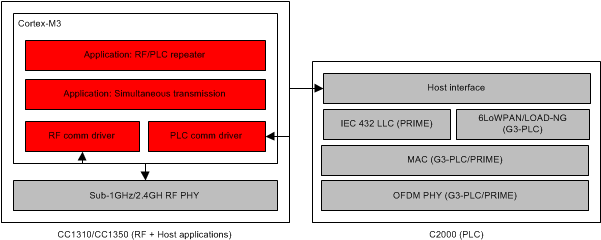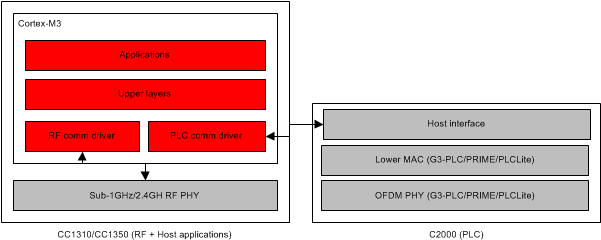JAJU787B April 2016 – May 2019 TPS2828 , TPS3828
1 System Description
This TI Design provides a reliable communication system solution with dual RF and PLC communications for end equipment of smart grid applications. This design is built on top of the existing TI PLC and RF solutions, which target at improving network performance and providing more features by combining the communication modems while keeping the advantages inherited from the existing PLC and RF solutions.
The programmable PLC design allows two options for the system design: one uses RF with a PLC full-stack based design (Figure 1), and one uses RF with a PLC lower-MAC stack based design (Figure 2). The former design takes full advantage of the embedded PLC network stacks, allowing multi-hop communications without additional effort in addition to the new features such as simultaneous transmissions, spatial multiplexing, PLC and RF repeaters, and support for two independent networks. The latter design allows the lower stacks (MAC or network layer) to control which physical layer (wireless or PLC) is used for each link over multi-hop networks. This capability cannot be supported by the former design.
Figure 1 shows the RF with a PLC full-stack based system architecture. The ARM® Cortex®-M3 processor in the CC1310 (or CC1350) Simplelink™ Wireless MCU is the CPU controlling both the RF and PLC links. For this design, the CC1310 Wireless MCU is connected to the C2000™ PLC MCU through UART to act as the PLC modem’s external host processor. The PLC MCU is loaded with the complete PRIME or G3-PLC software stack. The wireless MCU also runs the system’s host applications; for example, it simultaneously transmits packets on both networks or acts as a bridge between the different physical networks. The hybrid RF/PLC example project described in Section 4 implements this architecture with the full G3-PLC stack.

Figure 2 shows the RF with a PLC lower-MAC based system architecture. The only difference in this architecture is that the C2000 PLC device is loaded with PLC lower-MAC stack binary instead of full PLC stack. The benefit of this architecture is to allow building a single network layer to control both RF and PLC MAC or PHYs, which enables the network layer to select one of RF and PLC channels on a per-link basis over an entire multi-hop path. The decision algorithm of how to select one of the links (wireless or PLC) at the network layer can be implementation-specific. Note that this design is capable of building this type of architecture, but the software coming with this design does not provide any specific examples to work with this architecture.
The lower-MAC PLC software binary can be obtained from the G3-PLC DC or PRIME DC software package[5][6]. The PLCLite, TI’s proprietary PLC solution, includes MAC and PHY only, which can be downloaded from the TI-PLC-PLCLITE product page[8].
